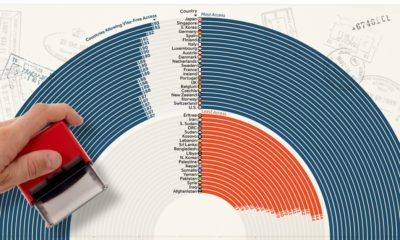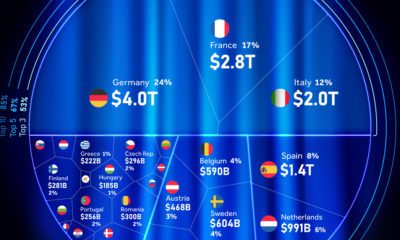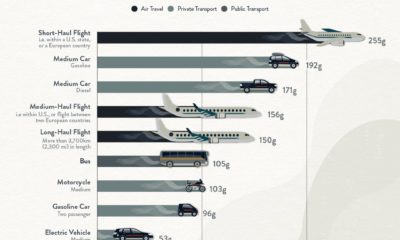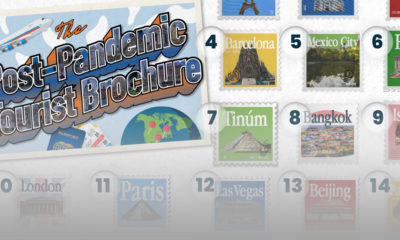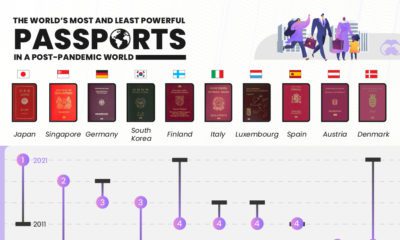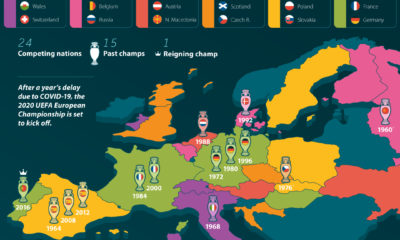This graphic uses survey data from Travel + Leisure (T+L) magazine to highlight the 25 top-ranked islands to visit around the world.
Methodology of the World’s Best Awards
Before diving in, it’s worth summarizing the methodology and briefly explaining how T+L compiled their findings. Each year, T+L conducts an annual global survey that uncovers the top travel experiences worldwide. In the survey, readers were asked to rate a range of things, including their favorite islands to visit. Islands were rated based on a few categories, including:
Activities and sights Natural attractions and beaches Food Friendliness Overall value
Each category was given a score of excellent, above average, average, below average, or poor. From there, each island’s final tally was calculated, based on the average scores across all categories. Below, we’ll dive into the 2022 rankings based on these scores.
The 5 Top-Ranked Islands to Visit
At the top of the list, there’s a good mix of European, Asian, and South Pacific islands. Here’s a look at the top five islands, along with some context that explains why respondents ranked them so highly:
1. Ischia, Italy
Nestled in the gulf of Naples about an hour away from the mainland, this charming volcanic island takes first place because of its charming villages, pristine beaches, and welcoming locals. It’s also well-known for its hot springs, which are easily accessible by either taxi or public transport.
2. The Maldives
Famous for its baby-blue waters, respondents ranked the Maldives as their second-favorite island destination. Located in the Indian Ocean, this collection of islands is well-known for stunning beaches, as well as excellent snorkeling and diving. With a wide range of luxury resorts, the Maldives is also a popular honeymoon destination.
3. Bali, Indonesia
This Indonesia island ranks third on the list because of its picturesque natural beauty, rich culture, and a diverse range of outdoor activities like surfing, diving, and hiking. It’s also well-known for its art, music, and traditional dance performances. As the only predominantly Hindu province in Indonesia, visitors get a chance to learn more about Balinese Hinduism.
4. Milos, Greece
Located in the Aegean Sea, Milos is well-loved by visitors because of its tranquil beaches. And while the island is a popular tourist destination, it offers a slightly slower pace that its neighbors Santorini or Mykonos.
5. Fiji Islands
This remote group of islands in the South Pacific Ocean ranked fifth on the list because of their rich marine life and friendly locals. Well-known for its excellent diving, it’s been labeled the “soft coral capital of the world.”
Top Ranking Islands, by Region
Seven of the top 25 island destinations are in Europe, making it first on the list by region. Southeast Asia comes in close second, with six islands in the top 25. As the data shows, a majority of the islands rank highly because of their beautiful beaches and thriving marine life. However, there are a couple of outliers on the list. One good example of an outlier is Mackinac Island, which is well-loved for its historical attractions (Mackinac Island is home to a colonial fort built in the 18th century). One thing is clear from these rankings—whether you’re a diver, a history buff, or a foodie, there are a number of world-class island destinations that offer an experience of a lifetime. on Even while political regimes across these countries have changed over time, they’ve largely followed a few different types of governance. Today, every country can ultimately be classified into just nine broad forms of government systems. This map by Truman Du uses information from Wikipedia to map the government systems that rule the world today.
Countries By Type of Government
It’s important to note that this map charts government systems according to each country’s legal framework. Many countries have constitutions stating their de jure or legally recognized system of government, but their de facto or realized form of governance may be quite different. Here is a list of the stated government system of UN member states and observers as of January 2023: Let’s take a closer look at some of these systems.
Monarchies
Brought back into the spotlight after the death of Queen Elizabeth II of England in September 2022, this form of government has a single ruler. They carry titles from king and queen to sultan or emperor, and their government systems can be further divided into three modern types: constitutional, semi-constitutional, and absolute. A constitutional monarchy sees the monarch act as head of state within the parameters of a constitution, giving them little to no real power. For example, King Charles III is the head of 15 Commonwealth nations including Canada and Australia. However, each has their own head of government. On the other hand, a semi-constitutional monarchy lets the monarch or ruling royal family retain substantial political powers, as is the case in Jordan and Morocco. However, their monarchs still rule the country according to a democratic constitution and in concert with other institutions. Finally, an absolute monarchy is most like the monarchies of old, where the ruler has full power over governance, with modern examples including Saudi Arabia and Vatican City.
Republics
Unlike monarchies, the people hold the power in a republic government system, directly electing representatives to form government. Again, there are multiple types of modern republic governments: presidential, semi-presidential, and parliamentary. The presidential republic could be considered a direct progression from monarchies. This system has a strong and independent chief executive with extensive powers when it comes to domestic affairs and foreign policy. An example of this is the United States, where the President is both the head of state and the head of government. In a semi-presidential republic, the president is the head of state and has some executive powers that are independent of the legislature. However, the prime minister (or chancellor or equivalent title) is the head of government, responsible to the legislature along with the cabinet. Russia is a classic example of this type of government. The last type of republic system is parliamentary. In this system, the president is a figurehead, while the head of government holds real power and is validated by and accountable to the parliament. This type of system can be seen in Germany, Italy, and India and is akin to constitutional monarchies. It’s also important to point out that some parliamentary republic systems operate slightly differently. For example in South Africa, the president is both the head of state and government, but is elected directly by the legislature. This leaves them (and their ministries) potentially subject to parliamentary confidence.
One-Party State
Many of the systems above involve multiple political parties vying to rule and govern their respective countries. In a one-party state, also called a single-party state or single-party system, only one political party has the right to form government. All other political parties are either outlawed or only allowed limited participation in elections. In this system, a country’s head of state and head of government can be executive or ceremonial but political power is constitutionally linked to a single political movement. China is the most well-known example of this government system, with the General Secretary of the Communist Party of China ruling as the de facto leader since 1989.
Provisional
The final form of government is a provisional government formed as an interim or transitional government. In this system, an emergency governmental body is created to manage political transitions after the collapse of a government, or when a new state is formed. Often these evolve into fully constitutionalized systems, but sometimes they hold power for longer than expected. Some examples of countries that are considered provisional include Libya, Burkina Faso, and Chad.
